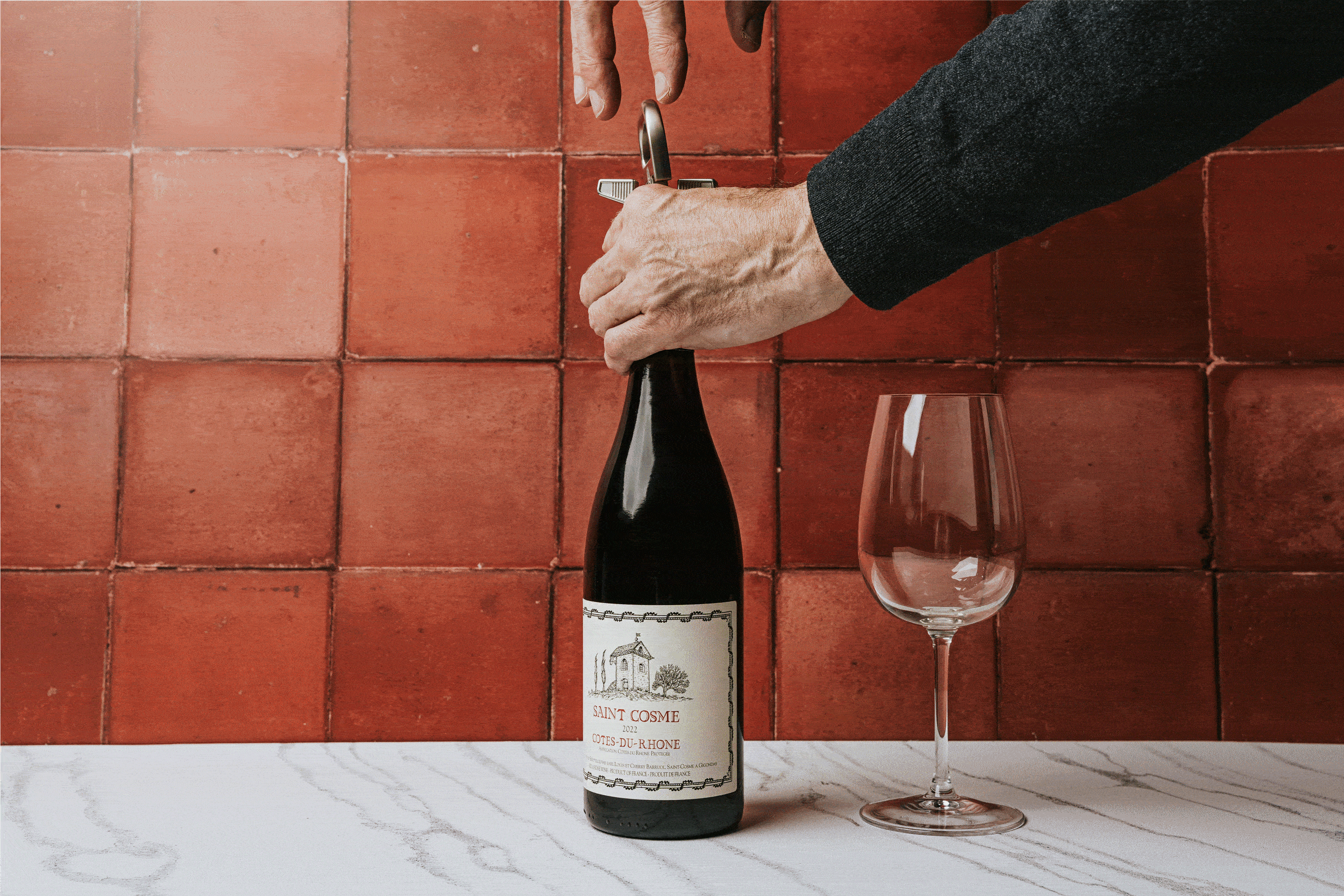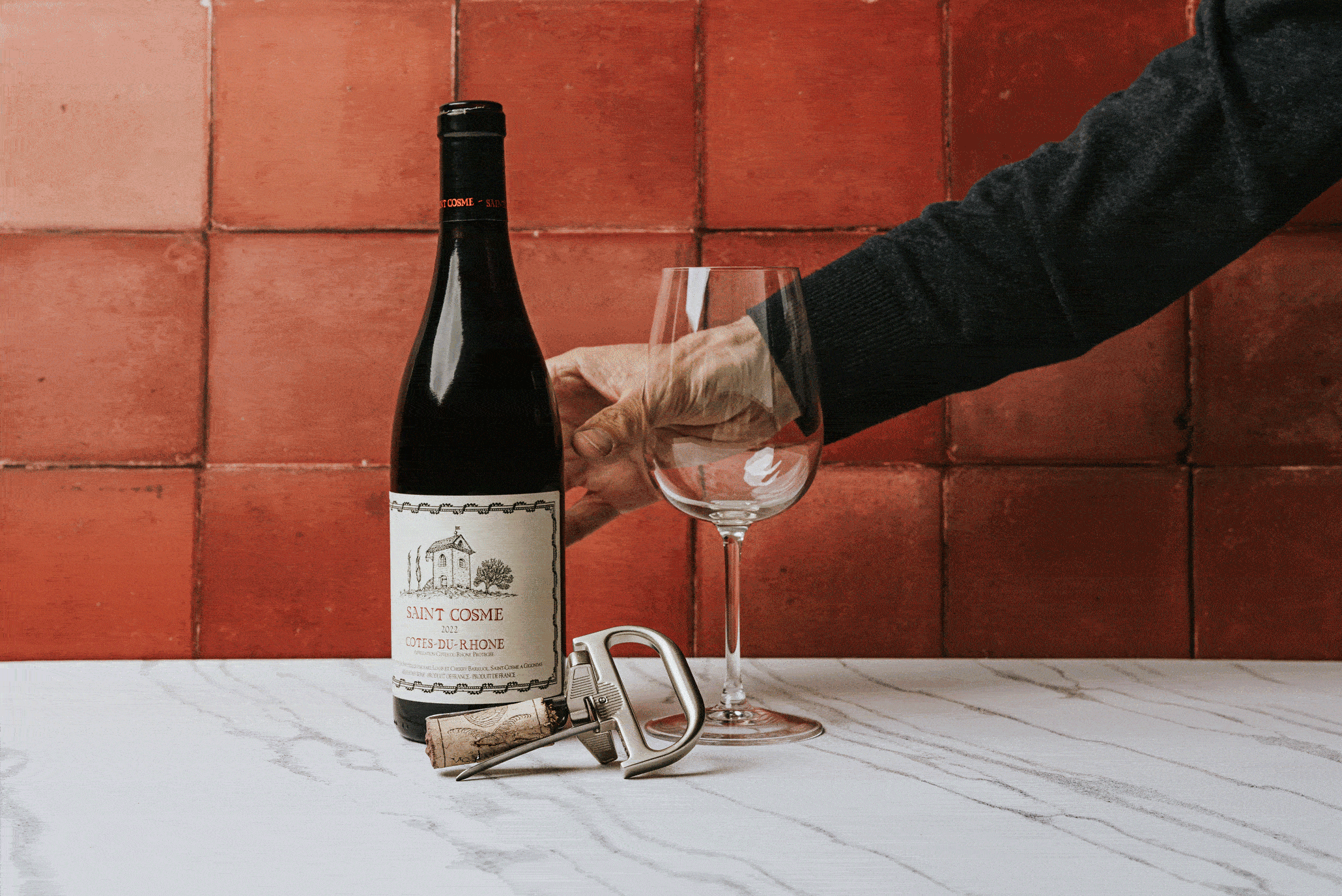“Wine” as a world, or as a subworld within the wider drinks world, is currently in a profound state of generational flux. From a sales and cultural perspective, the high-water mark of “natural” wine has clearly begun to ebb; mass-market and mass-produced wines like Josh and Sofia Coppola have become almost edgy in comparison, a sort of reverse-meme answer to the presumed cool hegemony of #natty. It’s left people who just genuinely and simply enjoy drinking wine—and who do not include “notes of dogma” as prerequisite to their drinking interest—feeling a touch unmoored. In a way it reminds me of the moment specialty coffee has experienced over the last five years, as more and more of these simulacra companies perform mimetic impressions of the third-wave coffee bar, optimized to extract hockey stick profit yield and little more. It’s become harder to tell at a glance if a place you might like—a coffee bar, a wine shop—actually gives an ounce (a carafe) of a shit about the artisan product they intend to sell, or if the whole thing is one big fake-out.
In a world of ever-creeping winey sameness—the same cartoon psychotropic cow labels on every ersatz reclaimed shelf, the same technicolor jars of imported sustainable tinned fish, the same transgressive $30 pinot blanc from Lesser Carpathia—it would be enormously helpful to be provided the occasional clear-as-day marker of a Good Wine Spot. The sort of thing whose very presence lets you know you’re somewhere worth your time. A rally point, a truism, a goddamn culturally self-evident shibboleth.
Spoken about in awed tones, revered by those who wield its great and uncanny power, there is happily such a divining rod of today’s modern wine world, a great and wonderful object whose implied intent—the safe removal of vintage wine corks from aged bottles—implies the sort of room one very much wishes to haunt.
I am referring to the Durand, a wine opening device that retails for $135. With apologies to the melon baller and the hydrogen rod, it is perhaps the greatest single-use utility object in the world today. You’ll find it at Enoteca Alessi in the historic core of Florence, among the barely traveled vintage Barolos; in Portland, Oregon, at Cru & Domaine, the city’s intellectual drinking hub; behind the bar at Noble Rot’s growing lexus-locai of wine restaurants across London; and at many other fine establishments in 40 countries around the world. If the wine shop you wander into far afield sells the Durand, the odds are in your favor.

It combines two tried-and-true pieces of the wine lover’s kit into a single, ingenious device. With the Durand, your standard hog-tail corkscrew is paired with the Ah-So (aka the butler’s friend), the two-pronged grabber meant to slide between glass and cork. First you insert the corkscrew (aiming for the very center of the cork, please), then you carefully edge the prongs down along either side of the cork. The Durand’s design allows for these two functions to fuse together at the point of leverage, enabling the cork puller to pull out even the most decrepit of corks.
The device’s inventor, Mark Taylor, is a 96-year-old Cornell University–trained engineer based in Atlanta, Georgia. Some 15 years ago—around the time he turned 80—Taylor applied his still-keen engineering mind to a problem that had plagued vintage wine lovers for at least a century: how to deal with old wine corks (fuck!) when they choose to crack and crumble (shit!) during the cork-pulling process (dammit!) like so much raw milk feta cheese.
“I was usually able to get corks out of older bottles,” Mark Taylor tells me, “but sometimes with difficulty—in pieces, or from inside of the bottle, or having to filter the bottle contents.” There had to be a better way. The inventor’s mind was stirred.
And lo, there came a-thundering that old lightning bolt, striking Mark Taylor fast and true, arriving like heaven to the very tip of his parietal lobe (the portion of the brain responsible for high cognition), revealing the somehow previously hidden answer to that most intractable of a wino’s woes.
After a few quick sketches, and this being Atlanta, Taylor contracted a gunmaker friend to help smith him up a few rudimentary prototypes with a modest budget. Each version got better and better, and test users across Atlanta were amazed at the device’s efficiency at deftly popping even the worst of corks. A series of wire drawings developed, and Taylor quickly began applying for patents on what he calls “the combination of a thinner, wider, shorter pitched corkscrew—used mainly to keep the cork from being pushed into the bottle and then only as an aid in extraction—together with the blades of an Ah-So.”
And so the Durand was born. Commercial production began in 2009. As of 2023, the brand owns patents in the UK, United States, Hong Kong, China, Australia, South Africa, and Canada. (The company politely declined to disclose annual sales figures.)
It is named for Yves Durand, an affable French expat sommelier who moved to Atlanta in the mid-1960s, whose early trench work at a restaurant called Rue de Paris helped foment what is now that city’s roaring food and wine scene. Durand was a nationally and internationally awarded sommelier in his prime, an author, and an Emmy Award winner who was quite well known locally for hosting epic wine tastings from his own cellar (a man after our own hearts). “He was a mentor to me,” says the inventor, and he’s not alone; few restaurateurs are cheered when they go, but Durand’s passing in 2019 was the stuff of lengthy tribute, garnering notice in the Atlanta Journal-Constitution and inspiring many a glass to be raised in testimonial tribute. (Taylor received permission from Yves before christening l’objet.)

Commercial sales of the Durand in London—at big boys like Hedonism Wines, Connaught Cellars, and a few others—began in 2010, and today the UK is now one of the brand’s top markets, thanks in no small part to an influential Jancis Robinson write-up in the Financial Times back in 2017. Janet Taylor, Mark’s daughter, cites the Durand’s ongoing embrace by such historic groups as Chaîne des Rôtisseurs, Commanderie de Bordeaux, Confrérie des Chevaliers du Tastevin, and more as being incredibly important for of the Durand’s dissemination across the heights of the wine industry, as well as by longtime advocates like Roy Hersch (For the Love of Port) and Todd French (Wine Berserkers, the influential North American wine message board).
Today the Durand remains a “closely held, private company,” per Janet. Production takes place in Taiwan, with more than 20,000 units sold worldwide in 2023. Mark has passed along the business and patents in retirement to his daughters, Janet and Elaine, and the device’s footprint continues to grow, but scaling has happened on their terms; the family firm has turned down multiple distribution offers from several large chains and magazines—including Williams Sonoma and Sur La Table—instead embracing a hand-to-hand sales style out of select wine shops worldwide, along with direct sales of units to customers online. “We simply don’t want to sell units for the sake of selling units,” Janet Taylor told me with great conviction. “We want the Durand in the hands of people who are going to use it properly.”
There’s something refreshing about this approach, which prizes direct sales and select retail over the whims and fathoms of mass commerce; it speaks to that old idea, all but dead in today’s world, in which exclusivity and a touch of dignified mystique might actually be a desirable thing. But there is also a true-blue, ardent-believer bent to the Taylor family’s approach. “There’s this aspirational idea, you know, that says people should want something even if they don’t really need it,” Janet Taylor tells me. “We’re the opposite. We try to get it to the individuals who really want to use it for dealing with old corks. If someone is only selling new wines, why would they have the Durand? If you’re only selling wines that cannot be laid down—wines that must be drunk within a five-year period—it’s not a product for you. We’ve turned away all the big-box stores, so many retailers, tons of people who want to carry it . . . because we believe it should only be sold by people who know when it should be used and why it should be used. It’s about putting it in the hands of people who need it.”
There’s something refreshing about this approach, which prizes direct sales and select retail over the whims and fathoms of mass commerce.
Mark Taylor may be retired from the business, but he continues to host a sort of living proof of concept for the device each year in Atlanta, at the Taylor family’s legendary annual invitation-only vintage wine tasting. (New York Times wine critic Eric Asimov is on the guest list, alongside a who’s who of American wine journalists and Masters of Wine.) “My dad became a collector of wines back when it wasn’t something that required wealth,” Janet Taylor tells me of her father’s weepingly deep collection of twentieth-century Bordeaux and Burgundy. “He has a lovely cellar thanks to the old ways of pricing, and now that he’s of a certain age, he’d like to drink them all.”
Perhaps he could invent us a time machine next. But therein lies what I think is especially important about the Durand: it implies a curiosity and encouragement for wine drinkers to seek out the older wines of yesteryear. And for a lot of today’s youngish wine drinkers—let’s say wine drinkers under 50—even thinking about this sort of stuff feels almost subversive, the level opposite of the prevailing hip-as-Brooklyn wine trends of the last decade. The Durand is an invitation for you to care about vintage wine, which, let me tell you: if your experience thus far with wine as a beverage is limited to frothy-fresh pét-nats or the latest new releases from the online wine club, drinking the wines of yesteryear is a true and distinct pleasure, and one I must implore you to seek out. Online auction websites (such as WineBid and K&L) have largely democratized the process of drinking older wines, allowing curious wine lovers to buy back vintage wines for the same price as (or sometimes even less than) contemporary releases. It doesn’t necessarily cost more; you just need to be tuned in—and armed with the proper tool for battling yesterday’s corks.

